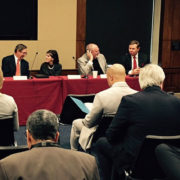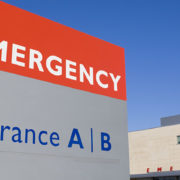Members of Congress have been looking for solutions to curb the rising cost of military healthcare, and on Nov. 3 representatives of US Family Health Plan briefed congressional officials about key features of the only fixed price, value-based capitated care program in the Military Health System.

U.S. Rep. Adam Smith (D-Washington), Ranking member of the House Armed Services Committee, introduces US Family Health Plan executives Linda Marzano (left) and David Chicoine (right) at a Nov. 3 Capitol Hill briefing on population health management.
“The US Family Health Plan is the alternative model of care that the country is striving for,” said Linda Marzano, chair of the US Family Health Plan Alliance’s board of directors and CEO of Pacific Medical Centers, located in Seattle. “We have high quality, high patient satisfaction and a lower cost of care. We are achieving what the entire country is trying to move toward.”
Patient-Centered Healthcare Leads to Member Satisfaction
Marzano’s remarks on Capitol Hill come after the Consumer Assessment of Healthcare Providers and Systems (CAHPS®) survey confirmed that US Family Health Plan patients are some of the most satisfied in the country. The CAHPS report this year showed that the US Family Health Plan’s aggregate member satisfaction rating in 2014 was 91.5 percent—more than 25 points higher on a 100-point scale than the national average for commercial health plans.

(Left to right) US Family Health Plan executives Linda Marzano (Pacific Medical Centers), David Chicoine (Brighton Marine Health Center) and David Howes (Martin’s Point Healthcare) discuss the high-quality, patient-centered healthcare that has been provided to military families for more than 30 years.
The six designated provider organizations that make up the US Family Health Plan operate a capitated-care model in which they are reimbursed at a fixed rate for the cost all patient services, and they are at risk if the cost of care exceeds that rate. This arrangement incentivizes investment in population health and disease management programs that help people live healthier lives and avoid expensive episodes of inpatient care.
“Each year, we’ve been able to offer great care at an affordable cost,” explained Dr. David Howes, president and CEO of Martin’s Point HealthCare. “Because people enroll with us, we know the people for whom we are responsible. We establish their preventive care needs, risks and chronic diseases, so we can help them to optimize their care, minimize hospitalizations and complications and remain healthy for as long as possible.”
David Chicoine, senior vice president and plan CEO for Brighton Marine Health Center, explained that each US Family Health Plan enrollee has an assigned primary care provider to coordinate care based on population models, health screenings and the patient’s previous medical history.
“Delivering very patient-specific healthcare is critical to achieving the high patient outcomes that we do,” Chicoine said.
“The Level of Care is Extraordinary”
Two US Family Health Plan members, retired Navy Rear Adm. Bill Center and retired Air

US Family Health Plan members—retired Navy Rear Adm. Bill Center (second from right) and retired Air Force Chief Master Sergeant Michael Tedford (far right) explain why the US Family Health Plan is the best option for their families’ healthcare.
Force Chief Master Sergeant Michael Tedford, explained why they chose the US Family Health Plan from among the TRICARE choices for health care. Tedford discussed how, after retiring from the U.S. Air Force, he and his family moved between various health providers before settling on the US Family Health Plan, and noted how the preventive care approach helped catch a significant illness at a very early stage.
“The plan’s focus on preventive care is high, and I think it’s really instituted in the culture of all the care providers,” Tedford explained. “It sort of mimics that old cliché—an ounce of prevention is worth a pound of cure. I’ve had nothing but good things to say about [the US Family Health Plan], and I plan on staying in it until I’m kicked out.”
Rear Admiral Center, who served the U.S. Navy for 35 years, noted the high quality care and personal respect he and his wife receive through the US Family Health Plan at Pacific Medical Center, which he touted as a model for future of the Military Healthcare System.
“The quality of care we’ve received is extraordinary,” he said. “I’m grateful we have this plan, and if it were up to me, I would want a plan like this for all military retirees. Our medical benefit is the most important of all of our retirement benefits, and when I talk to other retirees I get the same sentiment, especially as we grow older. [The US Family Health Plan’s] model lends itself to a true partnership between the military and retiree healthcare providers, and I think a seamless partnership is really important as we go forward in the future.”
















